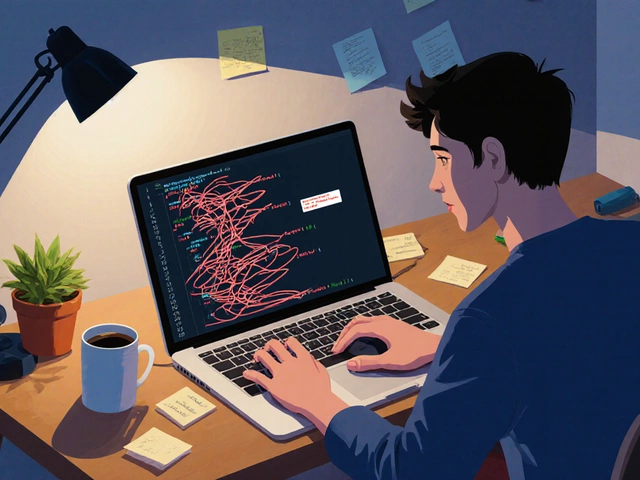
Which Programming Language Should You Learn First in Coding Classes?
Alright, you’ve decided to dive into the world of coding, but where do you start? The first language you choose can shape your experience and set the tone for your learning journey. Picking the right one isn't just about what's trending; it's about what aligns with your goals and how you like to learn.
Python often comes up in conversations about beginner-friendly languages. It's known for its readability and simplicity, making it a top pick for many. But Python isn't just easy; it's powerful. You can use it for web development, data science, machine learning, you name it!
Then there's JavaScript, which runs practically everywhere. If you’re interested in web development, JavaScript is your new best friend. It's the go-to for adding interactivity to websites. Plus, it's everywhere on the internet, so you're always a step away from learning something new.
- Why Your First Language Matters
- Python: The Friendly Giant
- JavaScript: The Web's Backbone
- HTML and CSS: Starting with Structure and Style
Why Your First Language Matters
Choosing your first programming language is like picking a musical instrument to start with. It shapes your initial experience and influences how easily you'll pick up other skills along the way. Start with something approachable, and you'll likely stick with it long enough to become proficient.
Impact on Learning Experience
Each language has its own syntax and logic. For instance, Python's clean and readable code makes it less intimidating for beginners, while JavaScript offers immediate visual feedback with what's happening on a web page. These key differences directly affect how quickly you get the hang of coding basics.
Long Term Benefits
Learning a foundational language like Python not only sets you up for success in coding classes but also makes picking up other languages easier down the line. Once you understand programming logic with one language, transferring those skills to another is often straightforward.
According to Guido van Rossum, the designer of Python, "The name Python originated from the British comedy troupe Monty Python, not from the snake." Known for its simplicity and readability, Python is a favorite among educators teaching coding to beginners.
Community Support and Resources
The size and vibe of a programming language's community can also be a game-changer. Larger communities often have more tutorials, forums, and problem-solving resources. Beginners in coding classes can find comfort in community support when they hit roadblocks. For Python and JavaScript, the online resources are practically endless.
The bottom line? Your first language is more than just a starting point—it's the launchpad for your entire coding journey. Choosing wisely can make your entry into coding not just easier, but also incredibly empowering.
Python: The Friendly Giant
If you're new to coding classes and seeking a gentle introduction, Python is the go-to buddy. Often dubbed the "friendly giant" of programming languages, it's beloved for its simplicity and versatility. The syntax reads almost like English, making it easier for beginners to wrap their minds around what's happening under the hood.
Why Python Stands Out
First off, Python's popularity isn't just hype. According to the 2023 Stack Overflow Developer Survey, Python was among the top five most-used languages, thanks to its broad applicability—from web and software development to vibrant fields like data science and machine learning. This popularity means you get a robust community that can provide tons of tutorials, forums, and resources.
What's also neat is that Python supports multiple programming paradigms, like procedural and object-oriented programming. This means you can start simple and explore more complex concepts as you get comfortable.
Real-World Applications
So, where can you actually use Python? It's everywhere! For web development, frameworks like Django and Flask are your tools of choice, both built on Python. If data is your game, libraries like NumPy and pandas offer powerful capabilities for data analysis. Python also shines in AI and machine learning with popular libraries like TensorFlow and PyTorch.
Getting Started with Python
Ready to take the plunge? Begin by installing Python from its official website; it's usually a no-fuss process. Once that's done, consider installing a beginner-friendly IDE like PyCharm or Anaconda, which comes loaded with useful packages.
- Install Python from the official Python website.
- Choose an Integrated Development Environment (IDE) such as PyCharm or Anaconda to streamline your workflow.
- Start exploring free online courses, like those offered by Codecademy or Coursera, to get hands-on practice.
Whether you're planning to work on web apps, dive into data science, or automate mundane tasks, Python is a massive door-opener in the coding classes realm. The more you play with it, the more you'll see why it's the trusty sidekick for many coders worldwide.

JavaScript: The Web's Backbone
If you’ve ever played around with a website, you've benefited from JavaScript. As a cornerstone of web technologies, alongside HTML and CSS, JavaScript is what makes websites dynamic and interactive. Whether you're clicking buttons, filling forms, or viewing complex animations, chances are JavaScript is at work.
One of the coolest things about learning JavaScript is its versatility. It doesn't just stay in the browser. Thanks to Node.js, you can run JavaScript on servers. This means you can use a single language for both front-end and back-end development. So, if you dream of building full-blown web applications from start to finish, mastering JavaScript is a no-brainer.
Why JavaScript for Beginners?
JavaScript is practically everywhere. With its huge community and countless resources online, help is always just a click away. Plus, being familiar with this language means you can easily experiment and see instant results directly on your web browser, without any complex setup.
Frameworks and Tools
Working with JavaScript doesn't mean reinventing the wheel every time. Frameworks like React, Angular, and Vue.js help make development faster and more efficient. These frameworks are hot topics in tech circles, and knowing them can ramp up your employability.
Here is a quick look at how different companies utilize JavaScript:
| Company | Use of JavaScript |
|---|---|
| Netflix | User Interface and API integration |
| React.js for UI development | |
| Multiple applications with Angular |
See how important JavaScript is in the real world?
If you’re thinking about learning to code but aren't sure where to start, JavaScript might be your best bet, especially if you’re interested in web development. It’s interactive, rewarding, and frankly, it’s a big player in the tech industry.
HTML and CSS: Starting with Structure and Style
When it comes to coding classes, there's no better way to get your feet wet than with HTML and CSS. They're the backbone of the web—every single website you visit is structured with HTML and styled with CSS. If you're interested in creating creatures of the internet, understanding these two is a must.
HTML, or Hypertext Markup Language, is all about giving your web page its structure. Think of it like the skeleton. It defines headings, paragraphs, lists—basically, the entire framework of the page. Plus, it’s easy to pick up. You can start writing basic code with just a text editor!
Why Start with HTML?
- It’s fundamental. Every web page uses it.
- Easy to learn with clear rules—a great confidence booster.
- Immediate feedback. Code something and see it live instantly.
Then you've got CSS, which stands for Cascading Style Sheets. While HTML provides the bones, CSS is what gives the page life and color—the skin, if you will. With CSS, you can control colors, fonts, spacing, and even lay out your page design. Imagine being able to transform a dull blocky page into a sleek, stylish masterpiece.
Benefits of Learning CSS
- Styling is just fun. You see changes in real-time, which is super satisfying.
- Pairs perfectly with HTML to create beautiful web projects.
- Responsive design skills. Master CSS, and any device will showcase your website beautifully.
With HTML and CSS under your belt, you open up a world of possibilities. You’re not just limited to static pages; combine them with a bit of JavaScript, and you've laid the groundwork for dynamic, interactive sites. By mastering the basics of structure and style, you're on your way to meaningful projects across the web.






Write a comment